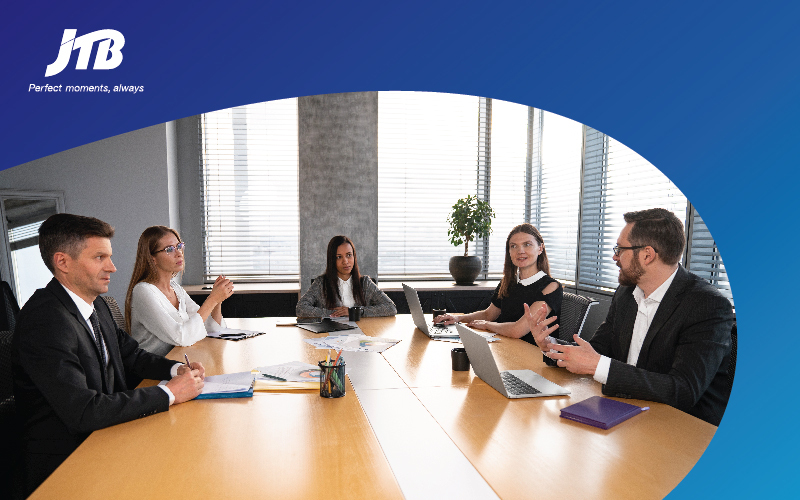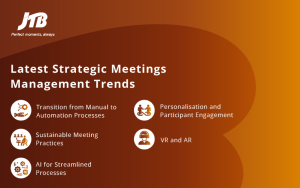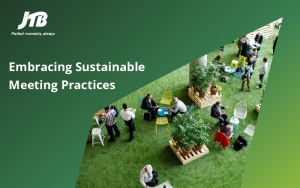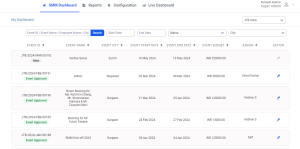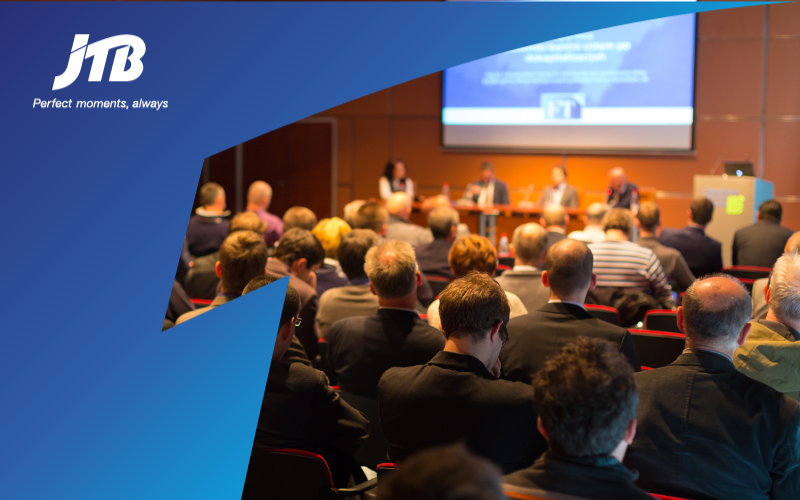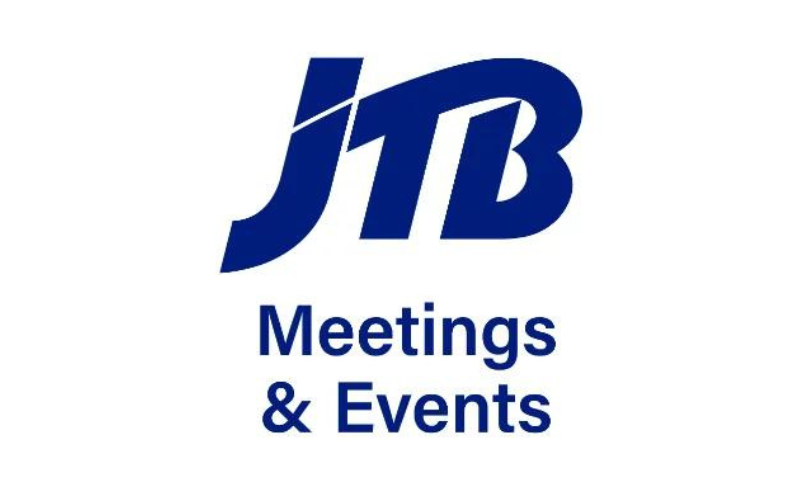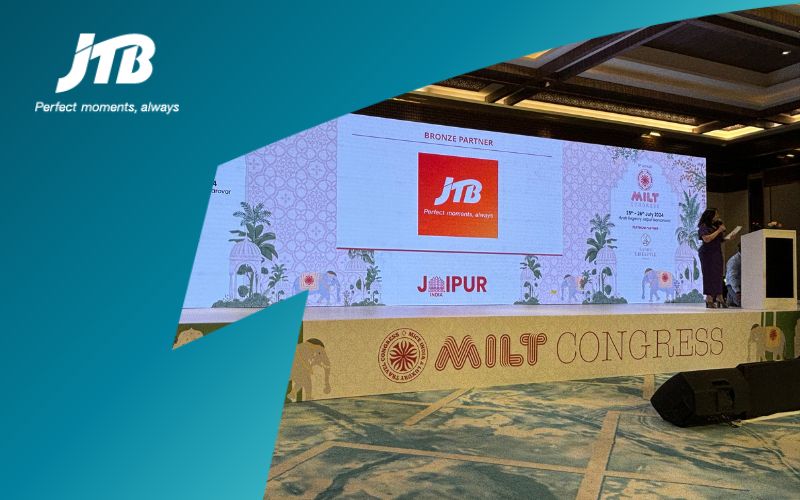Are your business meetings falling short of their potential? In today’s fast-paced corporate landscape, the effectiveness of meetings can make or break success. It’s not just about bringing people together—it’s about orchestrating them strategically. That’s where Strategic Meetings Management Trends come in, serving as your guiding compass through the dynamic world of meetings and events.
SMM is more than just scheduling and hosting—it’s a meticulous approach to planning, executing, and evaluating meetings to achieve organisational objectives. From budgeting to compliance, SMM ensures that every gathering contributes tangibly to your organisation’s goals.
But in a world where technology evolves rapidly and global events reshape priorities, the meeting landscape is constantly shifting. To stay ahead, businesses must embrace the latest strategic meetings management trends.
In this blog, we’ll explore the core components of SMM, uncover emerging trends, and offer practical insights to enhance your meeting strategies. Whether you’re an event planner or a business leader aiming to optimise your organisation’s practices, this blog is your go-to resource. Without further ado, let’s dive into the trends where each trend brings us closer to meeting excellence in today’s ever-changing world of business.
Latest Strategic Meetings Management Trends
Staying abreast of the latest strategic meetings management trends is crucial for organisations seeking to optimise their meeting strategies. Let’s delve into the intricacies of the latest trends:
Trend #1: Transition from Manual to Automated Processes
In recent years, there has been a significant shift in how organisations handle their strategic meetings. Traditionally, many aspects of SMM, such as event planning, attendee management and data tracking, were managed manually. This manual approach often led to inefficiencies, increased workload and a lack of centralised data management.
However, with advancements in technology, particularly in the realm of event management software and automation tools, organisations are increasingly transitioning towards automated processes.
Here’s a breakdown of why this transition is occurring and its implications:
1. Efficiency and Streamlining
Automated processes eliminate many of the manual tasks associated with strategic meetings management. Tasks such as attendee registration, data entry and communication can now be handled swiftly and accurately through automated systems. This streamlines operations, reduces the likelihood of errors and frees up valuable time for SMM professionals to focus on more strategic aspects of their roles.
2. Centralization of Data
Centralised platforms, like JTB Connect mentioned in the notes, play a crucial role in this transition. These platforms act as a hub where all relevant data pertaining to strategic meetings is stored and managed. By centralising data, organisations can gain a comprehensive view of their meetings portfolio, track key metrics and make data-driven decisions more effectively.
3. Enhanced Transparency
Automation fosters greater transparency in strategic meetings management processes. With data readily accessible and updated in real-time, stakeholders, including vendors and clients, can have clear visibility into the status of meetings, budgets and other relevant information. This transparency builds trust and facilitates smoother collaboration among all parties involved.
4. Cost Savings
Automating SMM processes often leads to cost savings for organisations. By reducing the need for manual labour and streamlining workflows, organisations can operate more efficiently and cost-effectively. Additionally, centralised platforms may offer features such as budget tracking and optimization tools, further helping organisations maximise their resources.
5. Scalability and Adaptability
Automated systems are inherently more scalable and adaptable to changing needs and circumstances. As organisations grow or encounter new challenges, automated processes can easily accommodate these changes without significant disruptions. This scalability ensures that organisations can effectively manage their strategic meetings portfolio regardless of size or complexity.
Overall, the transition from manual to automated processes in strategic meetings management represents a paradigm shift in how organisations approach event planning and execution. By embracing automation, organisations can unlock new efficiency, transparency and effectiveness levels in managing their strategic meetings, ultimately driving better outcomes and ROI.
Trend #2: Embracing Sustainable Meeting Practices
Amidst the bustling world of Strategic Meetings Management, a refreshing trend is taking root – the embrace of sustainable meeting practices. Picture this: gatherings that not only foster collaboration and innovation but also leave a positive impact on the planet. This evolution underscores a growing acknowledgment of the pivotal role sustainability plays in meeting planning and organisational responsibility.
Delving deeper into this trend unveils its significance. Sustainability isn’t just a buzzword; it’s a moral imperative and a strategic advantage. By weaving sustainability into meeting planning, organisations align themselves with global efforts to combat climate change. Moreover, it’s a tangible way to uphold corporate social responsibility, enhancing brand reputation, and fostering trust among stakeholders.
Now, let’s explore how to translate this vision into action. Embracing sustainable meeting practices involves adopting green initiatives and best practices. This includes embracing digital materials over print, selecting eco-friendly venues with LEED certifications, opting for locally sourced catering and encouraging eco-friendly transportation options like public transit or carpooling.
By embracing sustainability in meeting planning, organisations not only contribute to a healthier planet but also stand as beacons of responsible business practices in today’s increasingly conscious world.
Trend #3: Use AI and Automation for Streamlined Processes
Step into the future of Strategic Meetings Management – where meetings are finely tuned with the help of artificial intelligence (AI) and automation. This trend represents a significant leap forward in meeting management, offering organisations innovative tools to enhance efficiency and productivity.
At the heart of this trend lies the transformative power of AI and automation. These technologies revolutionise meeting management by automating routine tasks, analysing vast amounts of data to uncover insights, and enabling predictive analytics to optimise meeting outcomes. By leveraging AI and automation, organisations can streamline processes, reduce manual effort, and make data-driven decisions with precision.
Artificial intelligence holds promise in automating repetitive tasks, personalising attendee experiences, and predicting meeting outcomes. AI-powered chatbots, for example, can assist attendees with event inquiries, schedule appointments and provide personalised recommendations based on their preferences.
Tips for Incorporating AI into Meeting Strategies
Here are the tips for incorporating AI into meeting strategies presented in points for improved readability:
- Identify Key Areas: Start by pinpointing areas of meeting management where AI and automation can make the most significant impact. This may include tasks like scheduling, data analysis, or enhancing participant engagement.
- Explore AI Solutions: Once you’ve identified target areas, explore available AI-powered solutions that align with your organisation’s specific needs and budget. Look for tools or platforms designed to streamline meeting processes and enhance efficiency.
- Invest in Training: Prioritise employee training to ensure seamless integration of AI into your meeting strategies. Equip your team with the necessary skills and knowledge to effectively leverage AI tools and maximise their benefits in strategic meetings management.
By following these steps, you can effectively harness the power of AI to optimise your meeting strategies and drive better outcomes.
Trend #4: Personalization and Participant Engagement
In SMM, a pivotal trend is emerging – the focus on personalization and participant engagement. This trend recognizes the importance of tailoring meeting experiences to individual preferences and fostering active engagement among attendees.
Personalization is key to creating memorable and impactful meeting experiences. By catering to the unique needs and preferences of participants, organisations can enhance attendee satisfaction, foster deeper connections, and drive better outcomes.
Engaging attendees goes beyond traditional methods and requires innovative approaches. This may include interactive elements such as live polls, Q&A sessions, breakout discussions, and gamification. Incorporating multimedia content, storytelling, and experiential activities can also captivate participants and keep them actively involved throughout the meeting.
Measuring the impact of personalization on meeting success is crucial for evaluating effectiveness and refining strategies. Organisations can track metrics such as attendee satisfaction scores, engagement levels, post-meeting actions taken, and overall meeting outcomes. Analysing these metrics provides valuable insights into the effectiveness of personalization efforts and informs future decision-making.
One such innovative technology platform, JTB Connect, exemplifies this integration of technology into strategic meetings management. Designed by JTB India, JTB Connect offers a comprehensive solution for organisations aiming to streamline their event planning and execution processes. With features like centralised data management, automated workflows, and real-time analytics, JTB Connect simplifies the complexities of meeting management, ensuring seamless coordination and efficient outcomes.
By prioritising personalization and participant engagement, organisations can create more meaningful and productive meeting experiences that drive success.
Trend #5: Virtual Reality (VR) and Augmented Reality (AR)
Virtual reality enables immersive virtual environments where attendees can interact, collaborate, and engage with content in a realistic setting. Augmented reality, on the other hand, overlays digital information onto the physical environment, enhancing the attendee experience with interactive elements and real-time data visualisation.
These emerging technologies offer new opportunities for organisations to enhance meeting experiences, drive engagement, and stay competitive in a rapidly evolving landscape. By embracing these trends and integrating them into their SMM strategies, organisations can unlock new levels of innovation and effectiveness in meeting management.
The Future of Technology in SMM
Looking ahead, the future of strategic meetings management will be increasingly influenced by advancements, innovations and opportunities in technology. Organisations must stay proactive and adaptable, leveraging technology effectively to drive SMM success.
1. Advancements in Technology
Technological advancements, such as artificial intelligence (AI), machine learning and predictive analytics, will play a significant role in shaping the future of SMM. These technologies offer new possibilities for automating tasks, personalising experiences and optimising meeting outcomes.
2. Innovations in Meeting Experience
Innovative technologies like VR and AR will transform the meeting experience, offering immersive and interactive environments for attendees. These technologies will enable new forms of engagement, collaboration and content delivery, enhancing the overall impact of meetings and events.
3. Opportunities for Growth
As technology continues to evolve, new opportunities will emerge for organisations to innovate and differentiate in the SMM space. By embracing emerging technologies, exploring new strategies and adapting to changing trends, organisations can position themselves for growth and success in the dynamic landscape of strategic meetings management.
Adapting to the Changing Landscape: Strategies for Success
In the ever-evolving landscape of strategic meetings management success hinges on the ability to adapt to change. Here are key strategies to navigate the shifting terrain:
1. Agility and Flexibility in Meeting Planning
Flexibility is paramount in meeting planning. By embracing agility, organisations can swiftly respond to changing circumstances, adjust plans as needed and seize emerging opportunities. This nimble approach ensures that meetings remain relevant and effective in dynamic environments.
2. Investing in Employee Training and Development
Empowering employees with the necessary skills and knowledge is essential for meeting success. Investing in training and development equips staff with the tools they need to excel in their roles, adapt to new technologies, and navigate evolving meeting dynamics with confidence.
3. Leveraging Data Insights for Continuous Improvement
Data holds the key to unlocking valuable insights and driving continuous improvement in meeting management. By leveraging data analytics, organisations can identify trends, pinpoint areas for optimization and make informed decisions to enhance meeting effectiveness and efficiency over time.
4. Cultivating Strategic Partnerships with Suppliers and Vendors
Strategic partnerships with suppliers and vendors play a crucial role in meeting success. Collaborating closely with trusted partners ensures access to top-quality services, innovative solutions, and cost-effective resources. By nurturing these relationships, organisations can streamline operations, enhance value, and achieve mutual success.
By embracing these strategies, organisations can thrive in strategic meetings management, driving success and achieving their goals.
Conclusion
Strategic Meetings Management is an ever-evolving landscape that presents organisations with both challenges and opportunities. Throughout this blog, we’ve delved into key trends shaping the future of SMM, emphasising adaptability, innovation, and strategic planning as essential components for success.
From the transition from manual to automation processes to sustainability initiatives, the utilisation of AI, and the emphasis on participant engagement, we’ve explored various trends driving the evolution of SMM. These trends underscore the importance of proactive planning and staying informed in an ever-changing environment. This is where JTB India comes in and offers all these services hassle-free.
To thrive in the dynamic world of SMM, organisations must remain ahead of the curve. This entails embracing innovation, adopting trend-driven strategies, and maintaining flexibility to adapt to evolving needs and technologies.

